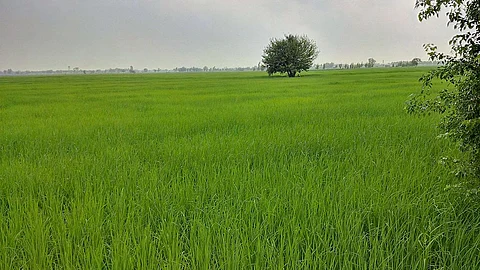
- Topics
- Feature
- Opportunities & Events
- About
- Hindi Portal
- Data
- Topics
- Feature
- Opportunities & Events
- About
- Hindi Portal
- Data

Plummeting groundwater levels in North India are threatening food security
India uses 57 percent of land area for food production, which consumes about 87 percent of the total freshwater. While the country has become self-sufficient in food production in last 30 years by growing wheat and rice, it is experiencing plummeting groundwater levels with excessive groundwater pumping for irrigation that is threatening food and water security in the region.
Parts of Punjab and the Ganga basin have experienced the highest groundwater depletion with around 58 percent of area being covered for irrigation from groundwater. Subsidised electricity has further increased reliance on groundwater for irrigation. However, agricultural policies aiming at meeting food demands while curbing groundwater depletion continue to receive a low priority informs this paper titled 'Groundwater sustainability in India through nonrice-dominated cropping pattern' published in PNAS Nexus.
Groundwater storage is declining at rates of more than 1 cm/ year in north India and rampant deepening of tube wells is increasing pumping costs. Solutions proposed to reduce groundwater pumping include improving irrigation efficiency, enhancing surface water storage, and altering cropping patterns.
Altering cropping patterns and moving toward less irrigation-intensive crops in the regions seems to be a feasible solution, needs to consider nutritional targets, farmers’ profit and food security concerns associated with reducing rice cultivation. However, very few studies explore the extent to which crop switching can help groundwater recovery in the current and projected future climate in north India.
Impact of crop switching on groundwater depletion in north India
This study integrates current satellite and well observations, and crop switching optimisation framework with hydrological modelling to estimate the role of crop switching scenarios on groundwater depletion in north India.
Rice is the dominant crop grown in north India covering 80 percent crop area while cereals account for 15 percent and pulses and oilseeds 5 percent of the area in the region. While the rice–wheat cropping system has improved food security, it has depleted groundwater resources at the rate of 31.3 km3year−1 for wheat and 21.3 km3year−1 for rice.
As high as 89 percent of crop area in North India is covered by rice with 80 percent under irrigation. Tube wells account for 59 percent of the irrigated area in the north of India. Satellite observations and model simulations confirm North India as a groundwater depletion hotspot.
Punjab has experienced the highest groundwater depletion rate of ∼5 cm/year, while Haryana, Uttar Pradesh, and West Bengal also witness a considerable depletion rate ranging from 2 to 4 cm/year. The current cropping pattern shows groundwater depletion at ∼2 cm/year with a total groundwater loss of about ∼300 km3 during 2002–2022.
The study uses two crop switching scenarios – one where crop-growing areas are redistributed as per the crop switching optimisation framework while meeting all the three objectives of meeting nutritional targets, farmers’ profit, and food security concerns (Crop Switch I, CSI). In the second scenario, rice production is compromised along with redistribution of crops as per the optimised crop fraction in each district (Crop Switch II, CSII).
The study finds that:
Crop switching substantially reduces groundwater depletion. For instance, under the CSI and CSII scenarios, groundwater loss could have been reduced by about 45 and 91 km3, respectively, in northern India during 2002– 2022. The CSI scenario can lead to groundwater savings of 13 and 22 km3 in Punjab and Uttar Pradesh, respectively. On the other hand, CSII can lead to groundwater savings of 21 and 53 km3 in Punjab and Uttar Pradesh, respectively during the same period.
Crop switch does not contribute to substantial groundwater recovery or depletion where depletion rates are low as in Himachal Pradesh, Uttarakhand, and Jharkhand. Therefore, optimising crop switch of rice crop to only districts with extensive groundwater pumping for irrigation can help limit groundwater withdrawal without substantially hampering rice production.
While increased rainfall cannot fully recover the lost groundwater under the current cropping pattern, crop switching can be valuable for groundwater sustainability under the warming climate and become an essential measure to enhance groundwater recovery in North India.
Crop switch is more effective in the regions that are extensively irrigated, dominated by rice, and groundwater pumping happens through deep tube wells.
Crop switching can aid in achieving food security and nutrition while increasing profits. For example, The CSI scenario exhibits a marginal increase in nutritional value, with a 1 percent rise in calorie content, 2.0 percent increase in protein, and a 13.5 percent boost in overall farmers’ profit in north India while maintaining almost the same rice production. On the other hand, the CSII scenario demonstrates a 1 percent increase in calorie content, 16.6 percent rise in protein values, and 86 percent rise in farmers’ profits. However, this comes at the expense of a notable (45 percent) decrease in rice production.
The crop switch can lead to lesser groundwater depletion in the projected future climate compared with the historical period (1995–2014).
The additional mean groundwater storage saved from CSI is projected to be 38–45 km3 in the near (2021–2040), 44–53 km3 in mid (2041–2060) and 49–54 km3 in far (2081–2100) periods depending on the emission scenario.
In the CSII scenario, the additional mean groundwater savings are 53–68 km3 in the near, 66–85 km3 in the mid and 77–96 km3 in the far periods, indicating that crop switching will have a positive impact on groundwater storage.
The paper argues for the need to incentivise district-level farmers to choose optimal crops that help reduce groundwater depletion by implementing proper strategies to overcome the difference in cost and support markets for alternative crops.
While transitioning from the rice to cereals will not only enhance irrigation water savings, but also offer greater more protein content compared with rice, political and socioeconomic barriers must be overcome to achieve both national food security and groundwater sustainability, argues the paper.